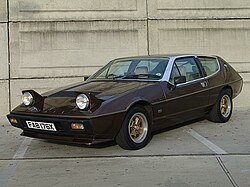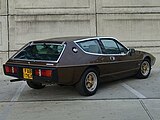Lotus Elite
Lotus Elite is the name for sports car models that the British car manufacturer Lotus Cars used for two different series .
Elite (Type 14, 1957-1963)
| lotus | |
|---|---|
|
Lotus Elite Fastback
|
|
| Type 14 | |
| Sales designation: | Lotus Elite |
| Production period: | 1957-1962 |
| Class : | Sports car |
| Body versions : | Coupe |
| Engines: |
Petrol engines : 1.2 liters (55-77 kW) |
| Length: | 3759 mm |
| Width: | 1506 mm |
| Height: | 1181 mm |
| Wheelbase : | 2242 mm |
| Empty weight : | 504 kg |
| successor | Lotus Elan |
The first Lotus Elite, the Type 14, was a very light, two-seater coupe. It was introduced at the London Motor Car Show in 1957 and was produced from 1957 to 1963.
After the Berkeley Sports of 1956, the Elite is the second series-production automobile with a self-supporting body made of fiberglass-reinforced plastic . The aerodynamically favorable body with a drag coefficient of 0.29 was designed by Peter Kirwan-Taylor and Frank Costin . It is made up of three shells. Two of them form the outer skin and the third the engine and the interior. The material of the plastic matrix was the epoxy resin , which was new at the time, and the body components were laminated by hand from glass fiber mats and resin. A laminated steel frame pulled around the windshield and reinforced the A-pillar, supported the door hinges and its lower ends served as a jack mount. The engine and front suspension were also on a laminated subframe. The body is prone to breakage at the force application points and the successor model Elan got a central tubular frame made of sheet steel, albeit a light (34 kg).
When it was presented at the London Motor Show in 1957, the Elite was the only overhead cam sports car made in England. The manufacturer Coventry Climax supplied the type FWE motor , which was developed from the motor of a portable fire service pump (type FW for "feather weight"). The housing and cylinder head were made of aluminum and therefore very light. The short-stroke (67 mm / 76 mm) four-cylinder in-line engine with a displacement of 1216 cm³ has dry cylinder liners, three crankshaft bearings and two parallel hanging valves per cylinder that are operated by bucket tappets. The forged crankshaft drives an intermediate shaft via a straight-toothed pair of spur gears at half speed, which transfers the power via a chain to the camshaft and via a helical gear drive to the distributor shaft with the oil pump. The inlet and outlet are on the same side of the cylinder head, the combustion chambers are wedge-shaped . With a compression of 8.5: 1, it delivers 55 kW (75 bhp) at 6100 rpm. Only this engine was offered over the entire construction period, but there were different tuning levels with up to 77 kW.
Coventry Climax was a leader in racing engines at the time, but made a living from engines for forklift trucks and fire engines. Some one-offs were built with the Lotus TwinCam engine - even after the Elite was officially built - and there were relatively many conversions to Ford Kent engines in the USA, since the Coventry Climax engines after the insolvency of the importer Jay Chamberlain no longer had a functioning spare parts supply.
The power is transmitted to the rear wheels via a four-speed gearbox. The front wheels are suspended from double wishbones, a "Chapman axle" is installed at the rear, i.e. wheel-guiding suspension struts with the drive shafts as wishbones and trailing arms, later triangle arms arranged diagonally (with two suspension points on the wheel carrier and one further forward in the middle). The brakes are from Girling, hydraulically operated without servo, with discs on all wheels, inside at the rear.
The Elite, of which only 988 units were produced, was intended as a sports car and was successfully driven in races. The Elite achieved first and second places in its class at Le Mans between 1961 and 1963.
Elite (Type 75/83, 1974–1982)
| lotus | |
|---|---|
|
Lotus Elite II
|
|
| Type 75/83 | |
| Sales designation: | Lotus Elite |
| Production period: | 1974-1982 |
| Class : | Sports car |
| Body versions : | Combi coupe |
| Engines: |
Petrol engines : 2.0 liters (117 kW) |
| Length: | 4457 mm |
| Width: | 1816 mm |
| Height: | 1206 mm |
| Wheelbase : | 2482 mm |
| Empty weight : | 1061-1111 kg |
| Previous model | Lotus Elan +2 (Type 50) |
| successor | Lotus Excel |
The second series had nothing in common with the original car apart from the name and was produced from May 1974 to December 1982.
This first Lotus estate coupe had a front engine, rear-wheel drive, independent suspension and, as a four-seater, was intended to appeal to upper-middle-class families. Like all production sports cars since the Elan, the Elite II also has a GRP body over a central tubular frame made of sheet steel. From 1980 this was galvanized. It was only with the Elise that this type of construction was deviated from.
From 1974 power steering and air conditioning were available as additional equipment. Originally only equipped with a five-speed manual transmission, it was also available with an automatic transmission from the beginning of 1976. The Elite II is the basis for the four-seater Eclat and Excel .
The Elite II is the first Lotus with the 907 engine. The inline four-cylinder engine with an aluminum cylinder block has two overhead camshafts and a displacement of 1973 cm³ and generates around 118 kW (160 hp) from it. The 907 engine eventually became the basis of the Esprit engines, both for naturally aspirated and turbo variants.
Individual evidence
- ↑ https://www.motorsportmagazine.com/archive/article/february-1958/12/interim-report-lotus-elite
- ^ The 50 Worst Cars of All Time - TIME . In: Time . September 7, 2007, ISSN 0040-781X ( time.com [accessed December 11, 2016]).





